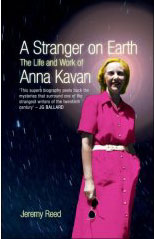A Stranger on Earth: The Life and Work of Anna Kavan

by Jeremy Reed
207 pages,
ISBN: 072061273X
Post Your Opinion | | Unveiling Anna Kavan
by Christopher Ondaatje
Devotees of Anna Kavan may well be surprised¨and perhaps a little put off¨that Peter Owen Publishers has brought out another biography of the acclaimed and esoteric author (Asylum Piece, Sleep Has this House, Ice, and Mercury). However, Jeremy Reed's prying book, A Stranger on Earth, has unearthed original material that uncovers a whole lot about someone who went to great lengths to turn herself into an enigma for posterity. This is a very different book from the somewhat fragmented volume, The Case of Anna Kavan, written by David Callard and also published by Peter Owen in 1992. Callard's biography gave us a primer on Kavan's extraordinary life while respecting her wish to exclude any meaningful information about her real self. Wanting to be judged solely on her creative output¨which was considerable¨she destroyed almost all of her personal correspondence, including all of her diaries, except for those spanning a short 18-month period.
Kavan changed her name, doctored her records with the intent to mislead future biographers, and anticipated becoming "the world's best-kept secret; one that would never be told." She almost succeeded. Jeremy Reed has, nevertheless, created the very personal biography Kavan had hoped to prevent. It must have been difficult for Reed to separate fact from fantasy.
Reed's book also reproduces an extraordinary collection of disturbing paintings by Kavan. Although these works did not fulfill her on the same level as her writing, they were nevertheless produced in parallel to her literary creations in the 1960s.
Anna Kavan died on December 4th, 1968, putatively of heart failure, but actually as a result of a lifetime's addiction to heroin. She had been preparing to inject herself with a shot that was still in the barrel of the syringe when she died. The plunger had not been depressed and she collapsed with the needle in her arm. She had a long history of attempted suicide and a propensity as a serious user to overdose.
Kavan was a gifted writer and a talented painter who endured an unhappy childhood, two failed marriages, and a long mutually-dependent relationship with her psychiatrist. She was born Helen Emily Woods on April 10, 1901, in Cannes, and in the first of a series of familial rejections, was sent away soon after she was born to be cared for by a nurse, before returning to live with her parents in West London. Denied any parental affection (she was allowed to see her mother for ten minutes each evening before dinner), she had a harsh introduction to an emotionally frigid world that would adversely affect her for the rest of her life.
When Kavan was six she was sent to an American boarding school where for the next seven years she suffered terribly, feeling betrayed, alienated, and lonely. She was often left in the school during holidays. When she was fourteen her father killed himself. Her mother, reacting against the social stigma of suicide, removed her daughter from her American boarding school and sent her to others, first in Switzerland, and later in England. At eighteen years of age, she was offered a place at Oxford but her socially scheming and egotistical mother dissuaded her from accepting it, and instead forced her to marry the lascivious Donald Ferguson, who was twelve years her senior. Ferguson took her to Burma, where he was an engineer on the railways. It was a disastrous decision both psychologically and sexually, which led in time to Kavan's extreme reaction against social convention, which forms the subject of Jeremy Reed's book.
Kavan began writing during her short-lived and explosive marriage to the alcoholic Ferguson. She published six novels under her married name, Helen Ferguson, between 1929 and 1937. During this period there was a second relationship to another bohemian alcoholic, Stuart Edmonds, a man of independent means. She started using cocaine heavily as a consequence of this second messy relationship, which ended before 1940.
Wishing in later life to eliminate entirely the facts of her past, Anna Kavan destroyed everything she had recorded about her troubled life, and in the 25 years in which she lived under the alias of Anna Kavan she expressed little or no interest in the novels she had published. From the 1940s onwards, Anna Kavan, a name she took from one of the fictional characters in her 1935 novel A Stranger Still, had no room in her life for Helen Ferguson.
Jeremy Reed's biography takes us through Kavan's tortuous addictive life and her various relationships. She established a long inseparable bond with her psychiatrist Dr. Karl Theodor Bluth, who advocated the use of drugs as an impetus for poetic vision. Kavan's dependency on Bluth, as both the source of her heroin and as an inseparable friend ended only upon his death in 1964. This unusually close relationship even included a suicide pact.
Kavan's numerous breakdowns, serious suicide attempts, devoted attraction to gay men, phobias, obsessions, hospitalisations, impoverishment, loneliness, and courage never excluded her need to write, and her work is now admired for the intensity of its vision by novelists as diverse as J.G. Ballard and Doris Lessing. The publication of her masterpiece, Ice, in 1967, a year before she died, helped considerably to enhance her literary reputation. In her last years she finally connected with an audience receptive to the way she saw the world. Her niche in cult literature is secure, and this is how she would have wanted to be remembered. She had no wish to be identified by facts of her earlier life, and there is little doubt that she would have repudiated this biography, fascinating though it may be, as a gross abuse of her privacy. ˛
Christopher Ondaatje is a trustee of the National Portrait Gallery and the author of Woolf in Ceylon.
|